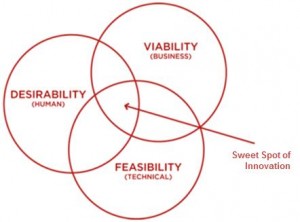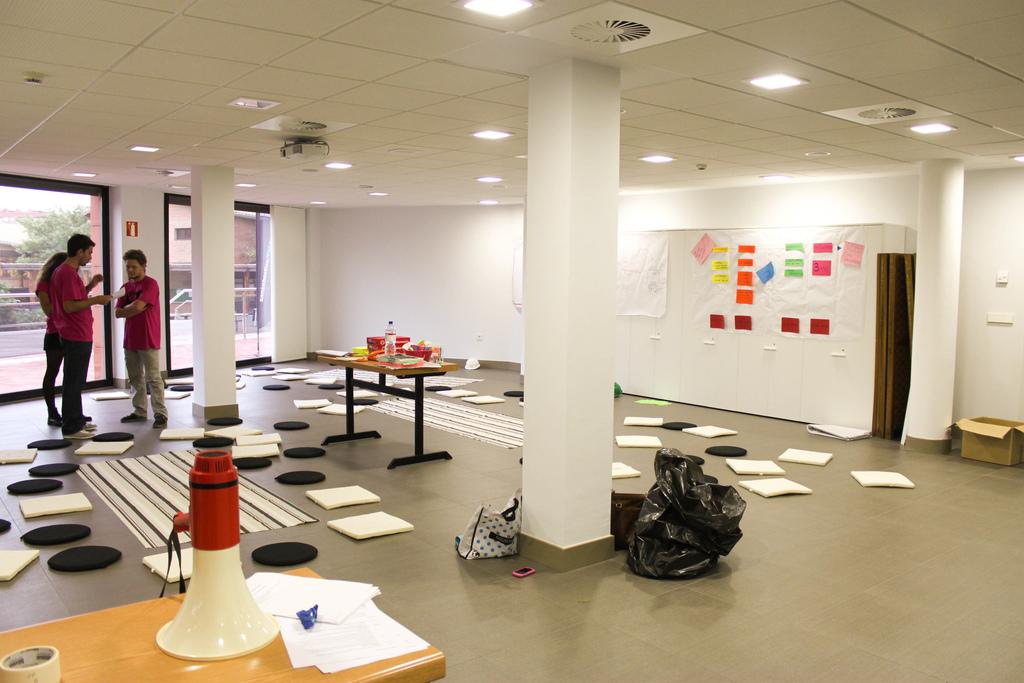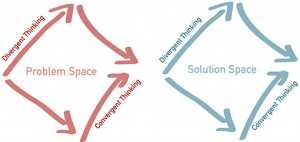Design Thinking – What it is & Why it Works
Design and Design Thinking
There are several understandings of "design". The most prominent interpretations are design is "with a capital D" and "with a small D". Design, with a capital D and design, with a small d. Design, with a small d, is rooted in human thinking for millennia in aesthetics and philosophy.
Instead, Design, with a capital D, has emerged recently in last-century academic circles as a unique discipline which its genuine tools, techniques, and processes. It has rich connections to product engineering, business, and liberal arts, (Buchanan 2002).
When we hear the notion of "Design Thinking" for the first time, in our mind associations to design with a small d, to aesthetics, might pop up immediately. Probably we would say "Yeah, - design thinking - it's about making things more beautiful, more admirable and desirable." – And at the first stance, we would be right. In the beginning, thinking about design was used to make things more pretty, to improve the looking and feeling.
But, there is a crucial point. Design focuses on single objects. Improving a teapot to make it more pretty has not necessarily have a high impact.

Changing the look of a teapot does not change the world, culture, or society dramatically. The way to heat tea or water isn't affected. However, replacing the teapot with a microwave oven might have a remarkable impact on culture and society.

Design thinking focuses not on single objects but on systems instead: the single object and its context of use as well the user. In this sense design is more than look-n-feel. As Steve Jobs phrased this in his own extreme consequence: "Design is how it works."
“Most people make the mistake of thinking design is what it looks like. People think it’s this veneer – that the designers are handed this box and told, ‘Make it look good!’ That’s not what we think design is. It’s not just what it looks like and feels like. Design is how it works.”
— Steve Jobs, Quotes on Design.
Design is how it works, (Steve Jobs). –"Form follows function" was an industrial and architectural design maxim starting in 19. th century. The notion "Form follows function" was coined in 1896 by the architect Louis Sullivan, (Sullivan 1896. The maxim became 1919-1933 very prominent in the Bauhaus product design philosophy. It was a kind of battle cry against products overwhelmed with too many adornments and for a dedicated plea for reductionistic design, to use as fewer ornaments as possible, and to experiment with new materials and technology. The Bauhaus style was one of the most influential currents in 20. th century modern design, Modernist architecture and art, design and architectural education.
Design thinking in its modern understanding came up in 1987 with Peter Rowe's book "Design Thinking", (Rowe, 1991). Peter Rowe was 1992 to 2004 Dean of the Graduate School of Design at Harvard, and chairman of the Urban Planning Design Department, at Harvard University.
In 1991 the design company IDEO showcased their design process which drew heavily on the Stanford curriculum. In Feb. 2002 IDEO founder David Kelley gave a now-famous TED talk where he defined design thinking as a human-centred problem-solution approach with empathy as a key characteristic. And, in 2005 Stanford Univ. d.school started teaching design thinking as a formal method.
“Be empathetic. Try to understand what people really value.”
— David Kelley, IDEO.
Design Thinking = Human-centred Problem-Solution Approach
Design thinking is an agile ideation method, strongly oriented to the user group’s needs of a potential, new product or service. It’s not about finding problems with existing solutions. It’s about unveiling the real customer needs.
"Co-designing products with customers is a better path to success than writing a business plan."
— Eric Ries, The Lean Startup
"Design thinking is a people-centred, collaborative and action orientated way to understand, reframe and solve problems.
It’s less about the look of an item and more about the need that a product or service meets for customers."— Murray Cox
"Design Thinking is a mindset. Design Thinking is about having an intentional process in order to get new, relevant solutions that create positive impact. It’s human-centered. It’s collaborative. It’s optimistic. It’s experimental."
— Eleanor Horowitz
The Sweet Spot of Innovation — Two Kinds of Thinking
There are three aspects which make a product, service or solution design successful: desirability, feasibility, and viability. In design thinking, we balance them properly to find the sweet spot of innovation: their intersection.

First, a solution, service, or product must be desirable. It has to fill customers' needs and fit into their lives. The customers need to want it. Another term is the product has to fulfil a certain job (Job to be done) for the customer. Customer desirability is "hiring the product to solve specific interests".
Desirability tests whether our innovation solves the right customer problem.
Second, to be successful, it is not enough that the product or service is wanted. We must also be able to realize the service resp. the product. The feasibility of our solution is about whether or not we are able to implement it in an effective manner. Feasibility not only affects our company’s operational capabilities to implement the product or service, but it also impacts the users’ experiences in a direct way. Remember the two sayings: "Be at the right time at the right place" and "Time must be appropriate."
This holds especially for new technologies. IBM launched 1992 the first touchscreen phone, Simon. It flopped. In 1997 Apple released the Newton PDA, a then-revolutionary device that combined a calculator, a calendar, an address book, and a note-taking app. It used a resistive touchscreen to make selections and input text (via early handwriting recognition). the first touchscreen phone. It flopped also. It took 10 years more before the iPhone brought 2007 success back home.
Feasibility tests whether your innovation strengthens your business.
Third, the commercial viability of our product or service is the crucial test of whether or not our innovation is viable now and in the future. Viability focuses on the value chain of our solution. Does our innovation align with our business goals? Will it contribute to our company's growth?
Viability tests your value chain for long-term sustainability.
In other words, design thinking brings the designer's view and engineering perspective together by balancing desirability, feasibility, and viability.
“Design thinking can be described as a discipline that uses the designer’s sensibility and methods to match people’s needs with what is technologically feasible and what a viable business strategy can convert into customer value and market opportunity.”
— Tim Brown CEO, IDEO.
"Design thinking is it is in a halfway house between analytical thinking, for the purely deductive and inductive logical thinking that utilizes quantitative methodologies to come to conclusions, and intuitive thinking, knowing without reasoning."
— Roger Martin, Dean of Rotman School of Management,
Univ. Toronto, HBR interview
Design Thinking and Innovation
What is the link between design thinking and innovation? — Innovative is a buzzword that undermines design because it is still trumpeted as a goal in and of itself. 1 Some researchers define innovation as a verb. From this action-oriented perspective, innovation:
"... extends beyond invention of new technology and includes a thoughtful and insightful application, delivery, extension, or recombination of existing technologies . . . the key is that an innovation is a valued leap from the viewpoint of consumers whether or not it is incremental from the producer's standpoint. " 2
Defining innovation as actionable has some benefits. First, it qualifies the ever-important newness with the word value. A product, service or system can be described as innovative. This usually implies a sense of newness, and, in this case, innovative is traditionally thought of as, and used interchangeably with, the word inventive. Second, valuable newness also implicitly recognizes the user of the product as being more important than the producer of the product. The user is closely linked to the notion of value and offers an argument for design methods that embrace people rather than technology.
Convergent and Divergent Thinking
The problem-solving habit in our daily lives and as well as in our business environment is rooted in science, engineering, and design thinking. The value of design thinking is in thinking differently about how to solve business and organisational challenges.
In Design Thinking the fundamental element is the Double Diamond metaphor applied in open-ended creative ideation (“Divergence Thinking”) and then focusing it through scientific hypothesis, inquiry, and testing rigour (“Convergence Thinking”).
In the so-called Problem Space, we diverge to open up to realize as much as possible potential problems views as possible. When all potential issues are on the table, we converge on the most possible, relevant problem. For this most prominent issue, we enter the so-called Solution Space. Again we diverge to find as many possible solutions, to finalise to converge to the relevant one.
Design Thinking is a multi-skilled process. We need people having experience in product development, product design, marketing, controlling, and legal.
Design Thinking Frameworks
https://www.oreilly.com/ideas/how-to-apply-design-thinking-in-your-organisation
Further Reading
- Buchanan, Richard. (2002): Wicked problems in design thinking. In V. Margolin, & R. Buchanan (Eds.): The idea of design (pp. 320). Cambridge, MA: MIT Press, 1996; and in Cagen, J., & Vogel, C.: Creating breakthrough products: Innovation from product planning to program approval. Upper Saddle River, NJ: FT Press. 2002.
- Kolko, Jon: "The Tenuous Relationship Between Design and Innovation". In Routledge's Artifact, Volume 1, Issue 3, 2007, p198 - 203.
- Ries, Eric (2011), The Lean Startup. Portfolio Penguin. Trade Paperback Edition, 2011.
- Roger, Martin: Applying Design Thinking to Your Business, HBR interview,
- Rowe, Peter (1991): Design Thinking. MIT Press; Reprint Edition, 1991.
- Sullivan, Louis H.: The tall office building artistically considered. Lippincott’s Magazine, March 1896. Getty Research Institute.
- Vogel, C. M., Cagan, J., & Boatwright, P (2005).: The design of things to come: How ordinary people create extraordinary products. Upper Saddle River, NJ: Wharton School Publications, 2005, p. 24.
: iNNoVaNDiS via flickr.com • Ashley Thredgold via flickr.com • Sammic SL via flickr.com, .
- Kolko, Jon: "The Tenuous Relationship Between Design and Innovation". In Routledge's Artifact, Volume 1, Issue 3, 2007, p198 - 203
- Vogel, C. M., Cagan, J., & Boatwright, P.: The design of things to come: How ordinary people create extraordinary products. Upper Saddle River, NJ: Wharton School Publications, 2005, p. 24








Leave A Comment